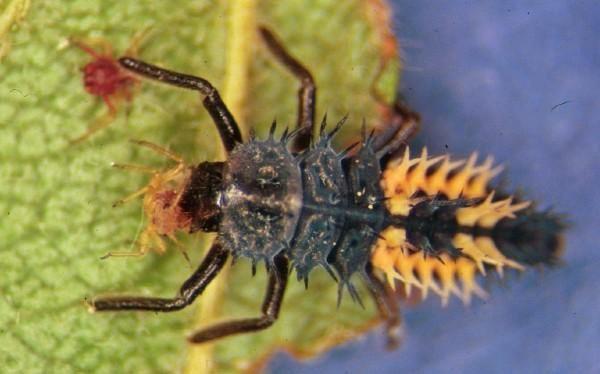
3 minute read
ASKtheexpert
Ask the Expert
By Debra Ricigliano Identifying Good Bugs
Q: I am a newbie gardener. Lately, I am finding creatures on my vegetable plants that look like tiny dragons. I am interested in identifying the insects that I find on my plants because I read about good and bad insects. Can you tell me what this is and if I should do anything about it? A: Is this what you are seeing (photo at right)? If so, they are the larvae of ladybird beetles (ladybugs). Finding them in your garden is a sign of natural pest control. Ladybug larvae consume many soft-bodied pests, such as aphids and spider mites. You are wise to identify what you find in your garden before doing anything because in many cases, being too aggressive can do more harm than good. Insecticide sprays can kill these beneficial insects. Where large aphid populations are devastating vegetable plants, you can spray horticultural oil or insecticidal soap, which are less harmful to ladybird beetles than many other insecticides.
Massive Cicada Activity
Q: There is massive cicada activity in my neighborhood. I live surrounded by mature trees with limbs that hang over into my backyard. I have many shrubs, mostly natives planted in my yard. After the female cicadas lay their eggs in the trees and when the larvae drop to the ground into my yard, will my shrubs be

Ladybug larvae photo by Whitney Cranshaw, Colorado State University, Bugwood.org.
damaged by cicadas that feed on plant roots? A: Periodical cicada nymphs feed underground on roots, but the feeding is so insignificant that it does not damage trees or shrubs. You have no cause for concern.
Dripping Ficus Tree
Q: My ficus tree has grown beautifully for years. Now the leaves are covered with a sticky liquid that drips onto the floor underneath. I moved the plant from inside to my screened-in porch, away from my other indoor plants. What is going on? A: What you describe is most likely a scale or mealybug infestation. Both of these insects suck on plant sap and excrete a “sticky liquid” called honeydew. It is good that you moved the plant away from your other indoor plants. Both of these insects are difficult to treat. Scales look like tiny brown bumps on leaves, typically found along the veins. Mealybugs are covered with white, powdery wax and are commonly found where leaves meet the stem (leaf axils). Look for a horticultural oil insecticide labeled for houseplants and treat according to the label directions. Multiple applications will be necessary. An alternative is a systemic indoor plant insecticide applied as a soil drench.
Damage on Maple Tree
Q: My maple tree is under attack. There are holes about 6" in diameter and probably 6–8" deep on some of the older limbs. I did not see this damage last year and it seems to have happened suddenly. What can be causing this and what should I do to stop it from happening? A: This sounds like the work of a pileated woodpecker. These impressivelooking birds drum on and drill holes in trees as they search for insects, mark territories, prepare nesting sites, and call to attract mates. Typically, holes are rectangular and their size can look alarming. They also can be a sign that the limbs are dead or dying. If the is tree poses any danger to people or property, it should be evaluated by a licensed arborist. o
Debra Ricigliano is a Certified Professional Horticulturist, who has worked as a horticulture consultant for the University of Maryland Extension Home and Garden Information Center since 1997. She is a graduate of the Institute of Applied Agriculture at UMCP. To ask a gardening question, go to http://extension.umd.edu/hgic and click on “Get Help.” Digital photos can be attached.










